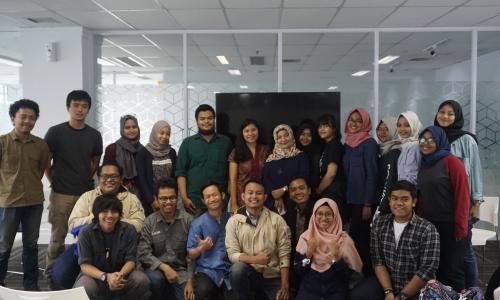
Institut Teknologi Bandung students visit WRI Indonesia
WRI Indonesia was delighted to receive a visit from 24 undergraduate students and two professors from the Institut Teknologi Bandung’s Forestry Engineering program on October 27, 2017. As a fairly new program of the university with only 3 generations, they were excited to take a look at a glimpse of life at an environmental think-tank. While their visit was only 3 hours, we managed to share a lot of information about WRI. The students also reunited with recent alumni of the program, Muhamad Nafi Andriansyah (Rian) and Dwiki. Rian and Dwiki currently work as young researchers of our newly launched Wahana Riset program.
Clorinda Wibowo, a WRI research analyst on energy and peat land issues, started off the session with an introductory presentation about WRI Indonesia. Clorinda highlighted our emphasis of translating data and information to action, and explained our ‘count it, change it, scale it’ approach to problem solving. Clorinda also gave a presentation on WRI’s work in forest restoration. She highlighted the alarming fact that 47% of Indonesia’s forests are deforested or degraded. She also highlighted that our restoration efforts are not just about planting trees, but also about achieving an economic, social and ecological balance of a landscape. She also shared a video showcasing the peat land conditions and the complexities of peat land management in Central Kalimantan after the devastating forest fires of 2015.
To follow, WRI’s GIS analyst Asti Asokawati presented on the One Map initiative, a collaborative initiative to synchronize various map references into one, so that it can be used as a tool for sustainable and equitable decision-making related to land use and governance. Asti discussed the complex process of achieving this one map, which includes but is not limited to resolving land and tenurial conflicts, providing informed consent, gathering both satellite and crowd sourced data, and working directly with communities.
Next, fellow GIS Analyst Surahman Putra gave an engaging presentation on the Global Forest Watch (GFW), a dynamic online forest monitoring system using satellite data, artificial intelligence and cloud computing. GFW was developed in the hopes that better forest information (in the form of more accessible and transparent data) will lead to better forest management. GFW’s ability to detect tree cover loss, carbon emissions, illegal logging and forest fires, among other uses, can lead to better forest loss prevention and understanding. These presentations were then followed by a question and answer session. The students were especially curious about the GFW tool and how we can get synchronized data as well as how we can attribute tree cover loss to humans, businesses, or natural causes.
Finally, Clorinda gave closing remarks on opportunities at WRI such as the Wahana Riset program, Indonesian Young Thought-Leaders on the Environment (IYTL), and the WRI internship program. We also encouraged the students to get engaged with our work through the Pantau Gambut tool. We hope that through this visit, we were able to further inspire these students into becoming the next environmental sustainability leaders of Indonesia. As devoted Forestry Engineering students, they already seem to be on the right track.